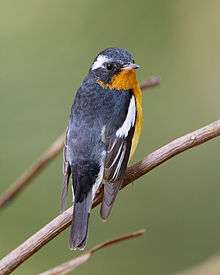Ficedula
| Ficedula | |
|---|---|
.jpg) | |
| Female red-breasted flycatcher Ficedula parva | |
| Scientific classification | |
| Kingdom: | Animalia |
| Phylum: | Chordata |
| Class: | Aves |
| Order: | Passeriformes |
| Family: | Muscicapidae |
| Genus: | Ficedula Brisson, 1760 |
| Species | |
|
30+, see text. | |
The Ficedula flycatchers are a genus of Old World flycatchers. The genus is the largest in the family, containing around thirty species. They have sometimes been included in the genus Muscicapa. The genus is found in Europe, Asia and Africa. Several species are highly migratory, whereas other species are sedentary.
The flycatchers in the genus Ficedula are typically small with slender bodies and rounded heads. In many cases they are sexually dimorphic in their plumage, with the males being brightly or strikingly coloured and the females being duller or drabber.[1]
The genus was introduced by the French naturalist Mathurin Jacques Brisson in 1760.[2][3] The genus name is from Latin and refers to a small fig-eating bird (ficus, "fig") supposed to change into the blackcap in winter.[4]
Species

The genus contains the following species:[5]
- European pied flycatcher, Ficedula hypoleuca
- Atlas pied flycatcher, Ficedula speculigera
- Collared flycatcher, Ficedula albicollis
- Semicollared flycatcher, Ficedula semitorquata
- Yellow-rumped flycatcher or Korean flycatcher, Ficedula zanthopygia
- Narcissus flycatcher, Ficedula narcissina
- Green-backed flycatcher, Ficedula elsae
- Mugimaki flycatcher, Ficedula mugimaki
- Slaty-backed flycatcher, Ficedula hodgsonii
- Rufous-chested flycatcher, Ficedula dumetoria
- Tanimbar flycatcher, Ficedula riedeli
- Rufous-gorgeted flycatcher, Ficedula strophiata
- Red-breasted flycatcher, Ficedula parva
- Taiga flycatcher, Ficedula albicilla
- Kashmir flycatcher, Ficedula subrubra
- Snowy-browed flycatcher, Ficedula hyperythra
- Little slaty flycatcher, Ficedula basilanica
- Rufous-throated flycatcher, Ficedula rufigula
- Cinnamon-chested flycatcher, Ficedula buruensis
- Damar flycatcher, Ficedula henrici
- Sumba flycatcher, Ficedula harterti
- Palawan flycatcher, Ficedula platenae
- Cryptic flycatcher, Ficedula crypta
- Bundok flycatcher, Ficedula luzoniensis (Split from F. hyperythra)[6]
- Furtive flycatcher, Ficedula disposita
- Lompobattang flycatcher, Ficedula bonthaina
- Little pied flycatcher, Ficedula westermanni
- Ultramarine flycatcher, Ficedula superciliaris
- Slaty-blue flycatcher, Ficedula tricolor
- Sapphire flycatcher, Ficedula sapphira
- Black-and-orange flycatcher, Ficedula nigrorufa
- Black-banded flycatcher, Ficedula timorensis
References
- ↑ Taylor, B. "Old World Flycatchers (Muscicapidae)". In del Hoyo, J.; Elliott, A.; Sargatal, J.; Christie, D.A.; de Juana, E. Handbook of the Birds of the World Alive. Lynx Edicions. Retrieved 30 May 2016.(subscription required)
- ↑ Brisson, Mathurin-Jacques (1760). Ornithologie, ou, Méthode contenant la division des oiseaux en ordres, sections, genres, especes & leurs variétés etc. (in French and Latin). Paris: Jean-Baptiste Bauche. Volume 1, p. 38; Volume 3, p. 369.
- ↑ Mayr, Ernst; Cotterell, G. William (1986). Check-list of Birds of the World. Volume 11. Cambridge, Massachusetts: Museum of Comparative Zoology. p. 335.
- ↑ Jobling, James A. (2010). The Helm Dictionary of Scientific Bird Names. London, United Kingdom: Christopher Helm. p. 167. ISBN 978-1-4081-2501-4..
- ↑ Gill, Frank; Donsker, David, eds. (2016). "Chats, Old World flycatchers". World Bird List Version 6.2. International Ornithologists' Union. Retrieved 20 May 2016.
- ↑ Moyle, R.G.; Hosner, P.A.; Jones, A.W.; Outlaw, D.C. (2015). "Phylogeny and biogeography of Ficedula flycatchers (Aves: Muscicapidae): Novel results from fresh source material" (PDF). 82: 87–94. doi:10.1016/j.ympev.2014.09.029.
Further reading
- Lei, X., Lian, Z.-M., Lei F.-M., Yin Z.-H., Zhao H.-F. 2007. Phylogeny of some Muscicapinae birds based on cyt b mitochondrial gene sequences. Acta Zoologica Sinica, 53(1):95 - 105. PDF fulltext
- Outlaw, D.C.; Voelker, G. (2006). "Systematics of Ficedula flycatchers (Muscicapidae): A molecular reassessment of a taxonomic enigma". Molecular Phylogenetics and Evolution. 41 (1): 118–126. doi:10.1016/j.ympev.2006.05.004.